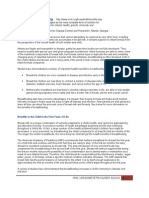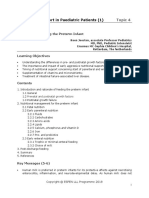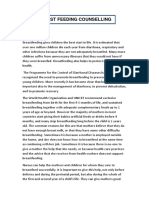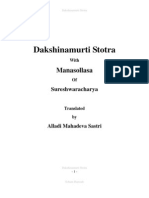Breastfeeding For Gut Infant Health: Badriul Hegar, Yvan Vandenplas
Breastfeeding For Gut Infant Health: Badriul Hegar, Yvan Vandenplas
Uploaded by
Dea Mustika HapsariCopyright:
Available Formats
Breastfeeding For Gut Infant Health: Badriul Hegar, Yvan Vandenplas
Breastfeeding For Gut Infant Health: Badriul Hegar, Yvan Vandenplas
Uploaded by
Dea Mustika HapsariOriginal Description:
Original Title
Copyright
Available Formats
Share this document
Did you find this document useful?
Is this content inappropriate?
Copyright:
Available Formats
Breastfeeding For Gut Infant Health: Badriul Hegar, Yvan Vandenplas
Breastfeeding For Gut Infant Health: Badriul Hegar, Yvan Vandenplas
Uploaded by
Dea Mustika HapsariCopyright:
Available Formats
REVIEW ARTICLE
Breastfeeding for Gut Infant Health
Badriul Hegar*, Yvan Vandenplas**
*Division of Gastroenterology-Hepatobiliary, Department of Child Health, Faculty of Medicine,
Universitas Indonesia/Dr. Cipto Mangunkusumo General National Hospital, Jakarta
**Department of Pediatrics, UZ Brussel, Vrije Universiteit Brussel, Brussels, Belgium
Corresponding author:
Badriul Hegar. Division of Gastroentero-hepatology, Department of Child Health, Dr. Cipto Mangunkusumo General
National Hospital. Jln Diponegoro No 71 Jakarta Indonesia. Phone: +62-21-3907742; Facsimile:+62-21-3907743.
E-mail: badriulh@gmail.com
ABSTRACT
Infants react sensible to dietary changes because the gut physiology and functionality is not fully mature. The
first few months of life is the 'window of opportunity' for optimal physical growth and development, cognitive
development, and emotional and social development. Exclusive breastfeeding is recommended for the first 6
months of life. Breast milk is important for the maturation of the infant’s digestive system. Potentially protective
factors are present in higher amounts in feces from breast-fed infant than from formula-fed infants. The amount of
intestinal bifidobacteria in breastfed infants is higher than in formula-fed babies. Mother's milk protects against
infection because it contains different factors with immologic properties. The differences in protein fractions
between human and cow milk are impressive. The human milk oligosaccharides are the third most important
nutritional component are fermented in the colon, making the environment in the colon suitable for the growth
of bifidobacteria and lactobacillus.
Keywords: breastfeeding, breast milk, window of opportunity, gut protection, optimal growth
ABSTRAK
Bayi bereaksi sensitif terhadap perubahan pola makan karena fisiologi dan fungsi usus yang belum sepenuhnya
matang. Beberapa bulan pertama kehidupan adalah 'window of opportunity' untuk pertumbuhan fisik dan
perkembangan optimal, perkembangan kognitif, serta perkembangan emosional dan sosial. Pemberian air
susu ibu (ASI) eksklusif dianjurkan untuk 6 bulan pertama kehidupan. ASI penting untuk pematangan sistem
pencernaan bayi. Faktor yang berpotensi protektif hadir dalam jumlah yang lebih tinggi pada feses bayi yang
diberi ASI daripada bayi yang diberi susu formula. Jumlah bifidobakteri usus pada bayi yang diberi ASI lebih
tinggi daripada bayi yang diberi susu formula. Air susu ibu melindungi dari infeksi karena mengandung faktor
yang berbeda, adanya sifat imologis. Perbedaan fraksi protein antara ASI dan susu sapi sangat mengesankan.
Oligosakarida susu manusia adalah komponen nutrisi terpenting ketiga yang difermentasi di usus besar, membuat
lingkungan di usus besar cocok untuk pertumbuhan bifidobakteri dan lactobacillus.
Kata kunci: menyusui, air susu ibu (ASI), window of opportunity, perlindungan usus, pertumbuhan optimal
INTRODUCTION
recommended that infants be exclusively breastfed for
Human milk is the first choice infant feeding. The 4-6 months with the introduction of complementary
exclusive breastfed infant with a normally diversified foods (any fluid or food other than breast milk).
maternal dietary intake is the gold standard. Before Thereafter, in 2001, after a systematic review and
2001, the World Health Organization (WHO) expert consultation, this advice was changed and
42 The Indonesian Journal of Gastroenterology, Hepatology and Digestive Endoscopy
Breastfeeding for Gut Infant Health
exclusive breastfeeding is now recommended for the Optimal Growth
first 6 months of life.1
Exclusive breastfeeding is nutritionally complete
Many data showed that formule feeding increased
for term infants and results in optimal growth. Mother's
the incidence of cow's milk protein allergy (CMPA) or
milk contains nutrients of high biological value,
atopic manifestation compared to breastfeeding (short-
stimulates the development of natural immunity, and
term prevention). The long-term benefit of a reduced
is above all practical, economical, convenient, and
inidence of atopic disease, cardio-vascular disease, and
rewarding because it stimulates the mother to child
other diseases are still on going study.
bonding.
The digestive system of a newborn is immature.
Window of Opportunity
Infants may lose up to 10% of their birth weight in
A window of opportunity is a period of time during the first days of his life, as they adjust using their own
which an intervention will result in short and long digestive system. The optimal infant feeding need to
term benefit, and is thus a critical period. The first contain a large amount of calories in a relatively small
few months of life is the 'window of opportunity' for; volume of food. Breast milk, with a high fat content, is
(1) Optimal physical growth and development (e.g. the most efficient way for infants to meet their caloric
weight and height gain); (2) Cognitive development needs.4
(e.g. language, non-verbal learning, attention, problem During the first 4-6 months of life, the digestive
solving, IQ); (3) Emotional and social development system undergoes enormous changes as it develops the
(e.g. emotional control, behavioral adaptation, social ability to produce enzymes to digest food, to develop
interaction). tolerance and antibodies offering protection. During
Infants react sensible to dietary changes because the first months of life, infants can not handle solid food
gut physiology and functionality is not fully mature. or large feedings, because their intestinal tract is not
The mucosa of the gut is not yet fully closed (relative suficiently developed and mature. Breast milk is a
absence of „tight junctions“); therefore large molecules food designed especially for infants to allow adapted
such as intact proteins, (pathogenic) bacteria pass maturation of the gastrointestinal tract.
relatively easy through the small intestinal mucosa into Lipase and bile salts, which aid in fat digestion, do
the bloodstream. The immune system is not yet fully not reach full levels until the age of 6 months. Human
developped as well. The first few months of life is a milk is rich in lipids (98% triglyceride), but contains
vulnerable period, in which a child’s immature immune bile salt-stimulated lipase which is an enzyme similar
system is constantly exposed to over one billion of to pancreatic lipase.4,5 Proteins and amino acids are
germs.2 Children with a poor immune system will be needed by infants in relatively important quantities to
more vulnerable to infection, including respiratory tract support their rapid growth rate. Protein requirements
infection, otitis media and gastroenteritis. An infant are met by adequate intake of breast milk. Breast milk
that suffers frequent infections will miss the window contains a variety of proteases, including trypsin,
of opportunity to develop its full potential.2 elastase, plasmin, etc that start digesting proteins as
soon as they are secreted. Breast milk also contains
Suboptimal Exclusive Breastfeeding antiproteases that serve to protect milk proteins from
degradation. The process of protein secretion and
Non-exclusive breastfeeding is associated with an
digestion in the mammary glands, depends on the
increased risk for many diseases such as necrotizing
balance of proteases and antiprotease.6 Unmodified
enterocolitis, otitis media, gastroenteritis, lower
cow’s milk is not suitable to feed an infant because
respiratory tract infections, atopic dermatitis, sudden
it is nutrionally unbalanced, has a high renal solute
infant death syndrome, childhood asthma, leukemia,
load (three times as much protein as as human milk,
type 1 diabetes mellitus and childhood obesity.
an excess of sodium), too low in iron, and fat that is
A socio-economic analysis concluded that the
difficult to be digested by the infant's gastrointestinal
burden of suboptimal breastfeeding is enormous: if 90%
system.
of all families could comply with the recommendation
to breastfeed exclusively for 6 months in the USA,
Gut Protection
this would result for the government in savings of 13
billion dollars per year on health care cost and prevent Breast milk is important for the maturation of
almost a thousand infant deaths.3 the infant’s digestive system. Colonies of beneficial
Volume 19, Number 1, April 2018 43
Badriul Hegar, Yvan Vandenplas
bacteria will develop in the intestine as a consequence First, cow's milk contains three times more protein than
of the presence of human milk oligosacchardes human milk. Breast milk contains 60% whey and 40%
and intestinal grorwth fatcors in mother's milk. casein while cow’s milk contains 20% whey and 80%
These beneficial bacteria help prevent an invasion casein. Whey breast milk contains mostly lactoferrin,
by pathogens and contribute to a heatly maturation alpha lactalbumin and immunoglobulin, whereas whey
process. The protective mucosal barrier in infant cow’s milk contains mostly Beta-lactoglobulin.11 A
is immature and puts infant at risk for infection. randomized clinical trial showed low protein in infant
Antibodies in breast milk help protect infants until formula is associated with lower weight up to age
the digestive mucosa matures and increases the ability 2 year, more similar to the weight gain in breastfed
to produce its own antibodies around the age of 4-6 infants.12,13 There is no convincing scientific evidence
months. that avoidance or delayed introduction of potentially
Secretory Immunoglobulin A (sIgA) constitutes the allergenic foods, such as fish and eggs would reduce
first line of defense, protecting the intestinal epithelium allergies, either in infants considered at increased
from enteric toxins and pathogenic microorganisms. risk for the development of allergy or in those not
sIgA promotes the clearance of antigens from the gut by considered to be at increased risk.14 If the incidence
blocking their access to epithelial receptors, entrapping of allergic manifestaions is higher in formula than
in mucus, and facilitating their removal by peristaltic in breastfed infants, is still a matter of debated. This
and mucociliary activities.7 sIgA in breast milk is is mainly due to the fact that breatsfeeding cannot
capable of binding commensal bacteria and may be be randomized, and that the most allergic families
involved in the progressive and controlled establishment breastfeed more frequently and longer.
microbiota of the newborn. The microbiota stimulates Mother's milk protects against infection because it
the maturation of the gut-associated-lymphoid-tissue contains different factors with immologic properties.
(GALT), resulting in the production of IgA with both Therefore, mothers milk influences the longterm
a limited affinity and repertoire to redundant epitopes immune response and risk for the development of
on gut microorganisms.8 auto-immune disease. sIgA, lactoferin, lysozym,
Potentially protective factors are present in higher lactoproxidase, oligosaccharides, bifidus factor,
amounts in feces from breast-fed infant than from etc act as anti-microbial agents; cytokines (IL-10
formula-fed infants. The sIgA level in breastmilk is and TGFB) and anti-idiotypic antibodies play an
high (1-2g /L in colostrum and 0.5-1 g/L in mature important role in the development of tolerance and
breastmilk). The sIgA levels in the feces of breastfed priming; macrophages, neutrophils, lymphocytes,
infants (0.11 + 0.07 mg/mL) was higher than in the cytokines, growth factors, hormones, nucleotides, milk
feces of standard formula-fed infants (0.03 + 0.01 mg/ peptide, adhesion molecules influence the immune
mL) at the age of one month of life.9 development, and TNF alpha and Il-6 receptors CD4,
Gut bacteria modulate the immune response. The cytokines, adhesion molecules, LC-PUFA, IL-1
amount of intestinal bifidobacteria in breastfed infants receptor antagonist, lactoferin, hormone and growth
is higher than in formula-fed babies. Mother's milk factors, etc. have anti-inflamatory properties.15
influences the specie sand amount of gut bacteria Lactoferrin is an iron binding protein, facilitating
through multiple factors, such as human milk iron uptake, and is resistant to trypsin digestion.
oligosaccharides, immunology active components, Lactoferin has a bacteriostatic effect since it has
nutrient content (e.g low protein and low phosphate), a high iron affinity and competition for iron with
etc. This microbiota will stimulate the reproduction of iron-dependant microbes. Lactoferrin has a strong
sIgA against some gastrointestinal pathogens such as bactericidal effect (independent from iron saturation),
E. coli, V. cholerae, C. difficile, Salmonella, Rotavirus, at least partly due to lactoferricin (bactericidal peptide
C. albicans.10 formed during digestion). Lactoferrin also decreases
the intestinal cell attachment of Enteropathogenic E.
Good Reason for Breastfeeding coli (EPEC). In vitro, lactoferricin is active against
Casein is a milk protein with diverse biologic HIV and C. albicans.16
consequences. What is good for the goose may be good Essential fatty acids (e.g. linoleic acid, alpha
for the gander, but what is good for the cow could be linolenic acid) can not be synthesized by the body, must
harmful to the human infant. The differences in protein therefore be supplied in adequate amounts by feeding.
fractions between human and cow milk are impressive. Essensial fatty acids are precursors of a number of
44 The Indonesian Journal of Gastroenterology, Hepatology and Digestive Endoscopy
Breastfeeding for Gut Infant Health
long-chain poly-unsaturated fatty acids (LCPUFAs). infections, especially infections of gastrointestinal and
The long-chain poly-unsaturated fatty acids consist upper respiratory tract.22 Nucleotides also respond
of arachidonic acid (ARA) and Docosohexanoic acid better to diphtheria, polio and influenza immunization.23
(DHA). Arachidonic acid acts in all cell membran as
modulator of cell immunity, and is pro-inflammatory.
CONCLUSION
Docosohexanoic acid is present mainly in neuronal
tissue (brain, retina) and has also an important role Human milk is the best, complete nutrition for
on the development of immune function, and has infants. It has anti-infective and anti-inflammatory
anti-inflammatory properties. The levels of DHA in effects by modulating the development of the immune
human milk lipids reflect the dietary intake of the response. Numerous human milk components and
mother. World-wide, the mean ratio of ARA and their interaction are involved in this complex process.
DHA in human milk is 1: 1, what ensures an adequate Research is neeeded to better understand the short
ARA status even in presence of DHA. Excessive and longterm effects of these specific nutrients and
LC-PUFA supplementation may induce a risk for breastfeeding as a whole. Opportunities for innovations
metabolic oxidation. ARA is efficiently metabolised in infant formula exist since many outcomes in
from linoleic acid. Excesses of ARA may lead to formula-fed infants differ from those in breastfed
undesirable inflammatory processes. Essential fatty populations. The development of these innovations
acids may possibly enhance the beneficial actions of with relevant outcome effects is complex, costly and
probiotics since LC-PUFAs promote the adhesion of time consuming.
probiotics to mucosal surfaces which increases their
health-promoting.17 Some studies showed abnormal
REFERENCES
fatty acids composition in umbilical cord blood in
infants at high risk of atopic diseases. Breast milk 1. Kramer MS, Kakuma R. The optimal duration of exclusive
breastfeeding: a systemic review. World Health Organization
from mothers of children with newly developed atopic 2002:14-20.
eczema has low levels of LC-PUFA.18,19 2. Doughty D. Structure and function of the gastrointestinal
The human milk oligosaccharides are the third tract in infants and children. J Wound Ostomy Continence
most important nutritional component after fat and Nurs 2004;31:207-12.
3. Bartick M, Reinhold A. The burden of suboptimal breastfeeding
lactose in human milk. Human milk oligosacharides
in the United States: a pediatric cost analysis. Pediatrics
act as receptor analogous for glycoconjugates on 2010;125:e1048-56.
epithelial and endothelial cells. Glycolipids and 4. Abrahamse E, Minekus M, van Aken GA, van de Heijning
glycoproteins mediate cell to cell interaction, bind B, Knol J, Bartke N, et al. Development of the digestive
system-experimental challenges and approaches of infant
humoral mediators, and modulate signal transfer.
lipid digestion. Food Dig 2012;3:63–77.
Human milk oligosacharides decrease the adhesion 5. Lindquist S, Hernell O. Lipid digestion and absorption
of invasive C. jejuni and the toxicity of heat stable in early life: an update. Curr Opin Clin Nutr Metab Care
E.coli enterotoxin.20 Human milk oligosacharides 2012;13:314–20.
are fermented in the colon, found in stools. The 6. Dallas DC, Underwood MA, Zivkovic AM, German GB.
Digestion of protein in premature and term infants. J Nutr
bifidobacteria and lactobacilli present in the colon Disorders Ther 2012;2:112.
will ferment oligosaccharides into energy and short 7. Mantis NJ, Roi N. Secretory IgA's complex roles in immunity
chain fatty acids (acetate, proprionate, butyrate), and mucosal homeostasis in the gut. Mucosal Immunol
making the environment in the colon suitable for 2011;4:603-11.
the growth of these bacteria. Lactic acid increases 8. Sekirov I, Russell SL, Antunes LC, Finlay BB. Gut microbiota
in health and disease. Physiol Rev 2010;90:859-904.
the motility and blood flow of the colon, stimulating 9. Köhler H, Donarski S, Stocks B. Antibacterial characteristics
the absorption of minerals. Butyric acid increases in the feces of breast-fed and formula-fed infants during the
the proliferation of colonic epithelial cells and fluid first year of life. J Pediatr Gastroenterol Nutr 2002;34:188-93.
absorption, and stimulates mucus production in the 10. Walter J, Ley RE. The human gut microbiome: ecology
and recent evolutionary changes. Annu Rev Microbiol
intestinal epithelium, while propionic acid decreases 2011;65:411-29.
the inflammatory mediators.21 11. Miller MJ, Witherly SA, Clark DA. Casein: a milk protein
Nucleotides are conditionally essential nutrients for with diverse biologic consequences. Proc Soc Exp Biol Med
infants with beneficial effects on the immune system, 1990;195:143-59.
lymphocyte maturation, antibody response to vaccines, 12. Escribano J, Luque V, Ferre N. Increased protein intake
augments kidney volume and function in healthy infants.
increase of sIgA, and decrease the incidence of various Kidney Int 2011;79:783-90.
Volume 19, Number 1, April 2018 45
Badriul Hegar, Yvan Vandenplas
13. Koletzko B , Closa R, Lower protein in infant formula is
associated with lower weight up to age 2 y: a randomized
clinical trial. Am J Clin Nutr 2009;89:1836-45.
14. Agostoni C, Decsi T, Fewtrell M. Complementary feeding:
a commentary by the ESPGHAN Committee on Nutrition. J
Pediatr Gastroenterol Nutr 2008;46:99-110.
15. Field CJ. The immunological components of human milk
and their effect on immune development in infants. CJJ Nutr
2005;135:1-4.
16. Edde L, Hipolito RB, Hwang FF. Lactoferrin protects neonatal
rats from gut-related systemic infection. Am J Physiol
Gastrointest Liver Physiol 2001;281:G1140-50.
17. Das UN. Nutrition 2002;18:786-9.
18. Beck M, Zelczak G, Lentze MJ. Abnormal fatty acid
composition in umbilical cord blood of infants at high risk of
atopic disease. Acta Paediatr 2000;89:279-84.
19. Businco L, Ioppi M, Morse NL, Nisini R, Wright S. Breast
milk from mothers of children with newly developed atopic
eczema has low levels of long chain polyunsaturated fatty
acids. J Allergy Clin Immunol 1993;91:1134-9.
20. Newburg DS, Shen Z, Warren CD. Quantitative analysis of
human milk oligosaccharides by capillary electrophoresis.
Adv Exp Med Biol 2000;478:381-2.
21. Guarner FI, Malagelada JR. Gut flora in health and disease.
Lancet 2003;361:512-9.
22. Schaller JP. Seminars in Fetal Medicine 2007;12:35-44.
23. Gutiérrez CP, Mora MI, Díaz-García L, Immune response to
nucleotide-supplemented infant formulae: systematic review
and meta-analysis. Br J Nutr 2007;98:S64.
46 The Indonesian Journal of Gastroenterology, Hepatology and Digestive Endoscopy
You might also like
- The Eight Healing Sounds of Yin Style Bagua: by David Parker100% (1)The Eight Healing Sounds of Yin Style Bagua: by David Parker1 page
- The Principles of Feeding of A Healthy BabyNo ratings yetThe Principles of Feeding of A Healthy Baby48 pages
- What Are The Advantages and Disadvantages of Breastfeeding?No ratings yetWhat Are The Advantages and Disadvantages of Breastfeeding?3 pages
- Prolactin Reflex (Milk Secretion Reflex)No ratings yetProlactin Reflex (Milk Secretion Reflex)16 pages
- exclusive breastfeeding for the first six (6) monthNo ratings yetexclusive breastfeeding for the first six (6) month15 pages
- Mother and Baby.: Practical Advice For Breast-FeedingNo ratings yetMother and Baby.: Practical Advice For Breast-Feeding38 pages
- Human Milk Benefits and Breastfeeding: Fani AnatolitouNo ratings yetHuman Milk Benefits and Breastfeeding: Fani Anatolitou8 pages
- Infant Nutrition: The First 12 Months of Life by Christina E. Schmidt Wood, MS, NENo ratings yetInfant Nutrition: The First 12 Months of Life by Christina E. Schmidt Wood, MS, NE17 pages
- Pediatric Nutrition and Nutritional Disorders: PediatricsNo ratings yetPediatric Nutrition and Nutritional Disorders: Pediatrics4 pages
- Nutrition Month 2011: Isulong Ang Breastfeeding - Tama, Sapat at Eksklusibo! (Tsek) ProgramNo ratings yetNutrition Month 2011: Isulong Ang Breastfeeding - Tama, Sapat at Eksklusibo! (Tsek) Program22 pages
- Breast Feeding Is The Normal Way of Providing Young Infants With The Nutrients They Need For Healthy Growth and DevelopmentNo ratings yetBreast Feeding Is The Normal Way of Providing Young Infants With The Nutrients They Need For Healthy Growth and Development8 pages
- Unit 2 Nutritional Consideration in Infancy and Preschool Years, Educational Platform100% (1)Unit 2 Nutritional Consideration in Infancy and Preschool Years, Educational Platform51 pages
- Topic - Breast Feeding Subject - Pediatrics Unit - Ii: Prepared by - Mr. Dinesh Khinchi H.O.D Pediatrics Kinsr KanpurNo ratings yetTopic - Breast Feeding Subject - Pediatrics Unit - Ii: Prepared by - Mr. Dinesh Khinchi H.O.D Pediatrics Kinsr Kanpur14 pages
- IGNOU Block 2 Unit 3 Nutrition For Infant, Child, Adolescent & Elderly0% (1)IGNOU Block 2 Unit 3 Nutrition For Infant, Child, Adolescent & Elderly20 pages
- A Study On The Magnitude of Diarrhea in BreastNo ratings yetA Study On The Magnitude of Diarrhea in Breast110 pages
- Unit-1 Infancy: S.Dharaneeshwari. 1MSC - Home Science-Food &nutritionNo ratings yetUnit-1 Infancy: S.Dharaneeshwari. 1MSC - Home Science-Food &nutrition16 pages
- Breast Feeding & Weaning: Supervisor DR: Hamsa Reda. Prepared By: GroupNo ratings yetBreast Feeding & Weaning: Supervisor DR: Hamsa Reda. Prepared By: Group19 pages
- Principles of Feeding The Preterm InfantNo ratings yetPrinciples of Feeding The Preterm Infant12 pages
- Lecture N4 Breast-Feeding. Value and Advantages of Breast-Feeding. Methods of Calculation of Daily Volume of Feeding. Weaning at Breast Feeding100% (1)Lecture N4 Breast-Feeding. Value and Advantages of Breast-Feeding. Methods of Calculation of Daily Volume of Feeding. Weaning at Breast Feeding7 pages
- PedsCase Infant Nutrition 6 To 24 MonthsNo ratings yetPedsCase Infant Nutrition 6 To 24 Months7 pages
- Pediatrics Report Group 2 Feeding and NutritionNo ratings yetPediatrics Report Group 2 Feeding and Nutrition23 pages
- Breast-Feeding and Risk For Childhood Obesity: Does Maternal Diabetes or Obesity Status Matter?No ratings yetBreast-Feeding and Risk For Childhood Obesity: Does Maternal Diabetes or Obesity Status Matter?7 pages
- Breastfeeding Linked With Long-Term Reduction in ObesityNo ratings yetBreastfeeding Linked With Long-Term Reduction in Obesity3 pages
- Review Article: The Role of Long-Chained Marine N-3 Polyunsaturated Fatty Acids in Cardiovascular DiseaseNo ratings yetReview Article: The Role of Long-Chained Marine N-3 Polyunsaturated Fatty Acids in Cardiovascular Disease16 pages
- Energies: Business Models in The Smart Grid: Challenges, Opportunities and Proposals For Prosumer ProfitabilityNo ratings yetEnergies: Business Models in The Smart Grid: Challenges, Opportunities and Proposals For Prosumer Profitability30 pages
- Module 11 Middle Adulthood Physical Cognitive and Socioemotional DevelopmentNo ratings yetModule 11 Middle Adulthood Physical Cognitive and Socioemotional Development13 pages
- 255 Church ST, Fredericton, NB - Hjksz@stu - Ca - 902-476-0698No ratings yet255 Church ST, Fredericton, NB - Hjksz@stu - Ca - 902-476-06983 pages
- Philosophy of School Curriculum From Various Perspectives Education EssayNo ratings yetPhilosophy of School Curriculum From Various Perspectives Education Essay25 pages
- G8-HEALTH-Teenage Concerns and Management of Sexuality-Related IssuesNo ratings yetG8-HEALTH-Teenage Concerns and Management of Sexuality-Related Issues35 pages
- SPR-00 Sekilas Tentang NQAF Indonesia (Final Rev) - English VersionNo ratings yetSPR-00 Sekilas Tentang NQAF Indonesia (Final Rev) - English Version48 pages
- Ex No: 6 Raw Sockets (Packet Capturing & Filtering)No ratings yetEx No: 6 Raw Sockets (Packet Capturing & Filtering)6 pages
- The Eight Healing Sounds of Yin Style Bagua: by David ParkerThe Eight Healing Sounds of Yin Style Bagua: by David Parker
- What Are The Advantages and Disadvantages of Breastfeeding?What Are The Advantages and Disadvantages of Breastfeeding?
- exclusive breastfeeding for the first six (6) monthexclusive breastfeeding for the first six (6) month
- Mother and Baby.: Practical Advice For Breast-FeedingMother and Baby.: Practical Advice For Breast-Feeding
- Human Milk Benefits and Breastfeeding: Fani AnatolitouHuman Milk Benefits and Breastfeeding: Fani Anatolitou
- Infant Nutrition: The First 12 Months of Life by Christina E. Schmidt Wood, MS, NEInfant Nutrition: The First 12 Months of Life by Christina E. Schmidt Wood, MS, NE
- Pediatric Nutrition and Nutritional Disorders: PediatricsPediatric Nutrition and Nutritional Disorders: Pediatrics
- Nutrition Month 2011: Isulong Ang Breastfeeding - Tama, Sapat at Eksklusibo! (Tsek) ProgramNutrition Month 2011: Isulong Ang Breastfeeding - Tama, Sapat at Eksklusibo! (Tsek) Program
- Breast Feeding Is The Normal Way of Providing Young Infants With The Nutrients They Need For Healthy Growth and DevelopmentBreast Feeding Is The Normal Way of Providing Young Infants With The Nutrients They Need For Healthy Growth and Development
- Unit 2 Nutritional Consideration in Infancy and Preschool Years, Educational PlatformUnit 2 Nutritional Consideration in Infancy and Preschool Years, Educational Platform
- Topic - Breast Feeding Subject - Pediatrics Unit - Ii: Prepared by - Mr. Dinesh Khinchi H.O.D Pediatrics Kinsr KanpurTopic - Breast Feeding Subject - Pediatrics Unit - Ii: Prepared by - Mr. Dinesh Khinchi H.O.D Pediatrics Kinsr Kanpur
- IGNOU Block 2 Unit 3 Nutrition For Infant, Child, Adolescent & ElderlyIGNOU Block 2 Unit 3 Nutrition For Infant, Child, Adolescent & Elderly
- Unit-1 Infancy: S.Dharaneeshwari. 1MSC - Home Science-Food &nutritionUnit-1 Infancy: S.Dharaneeshwari. 1MSC - Home Science-Food &nutrition
- Breast Feeding & Weaning: Supervisor DR: Hamsa Reda. Prepared By: GroupBreast Feeding & Weaning: Supervisor DR: Hamsa Reda. Prepared By: Group
- Lecture N4 Breast-Feeding. Value and Advantages of Breast-Feeding. Methods of Calculation of Daily Volume of Feeding. Weaning at Breast FeedingLecture N4 Breast-Feeding. Value and Advantages of Breast-Feeding. Methods of Calculation of Daily Volume of Feeding. Weaning at Breast Feeding
- Breast-Feeding and Risk For Childhood Obesity: Does Maternal Diabetes or Obesity Status Matter?Breast-Feeding and Risk For Childhood Obesity: Does Maternal Diabetes or Obesity Status Matter?
- Breastfeeding Linked With Long-Term Reduction in ObesityBreastfeeding Linked With Long-Term Reduction in Obesity
- Review Article: The Role of Long-Chained Marine N-3 Polyunsaturated Fatty Acids in Cardiovascular DiseaseReview Article: The Role of Long-Chained Marine N-3 Polyunsaturated Fatty Acids in Cardiovascular Disease
- Energies: Business Models in The Smart Grid: Challenges, Opportunities and Proposals For Prosumer ProfitabilityEnergies: Business Models in The Smart Grid: Challenges, Opportunities and Proposals For Prosumer Profitability
- Module 11 Middle Adulthood Physical Cognitive and Socioemotional DevelopmentModule 11 Middle Adulthood Physical Cognitive and Socioemotional Development
- 255 Church ST, Fredericton, NB - Hjksz@stu - Ca - 902-476-0698255 Church ST, Fredericton, NB - Hjksz@stu - Ca - 902-476-0698
- Philosophy of School Curriculum From Various Perspectives Education EssayPhilosophy of School Curriculum From Various Perspectives Education Essay
- G8-HEALTH-Teenage Concerns and Management of Sexuality-Related IssuesG8-HEALTH-Teenage Concerns and Management of Sexuality-Related Issues
- SPR-00 Sekilas Tentang NQAF Indonesia (Final Rev) - English VersionSPR-00 Sekilas Tentang NQAF Indonesia (Final Rev) - English Version
- Ex No: 6 Raw Sockets (Packet Capturing & Filtering)Ex No: 6 Raw Sockets (Packet Capturing & Filtering)
































































































